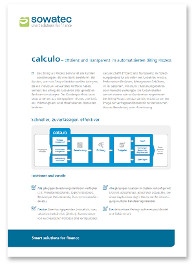The billing process includes all customer billing activities performed by a bank. For customers who have an individually managed portfolio (e.g. for institutional investors), billing comprises the fees for all the banking services that were used. The customer portfolio may contain securities (funds and equities), currency balances or structured products and more.

Billing
-
Typical types of fee in billing:
All-in fees
Flat fee that covers all costs of the portfolio and includes both taxable and tax-exempt components.
Discounts
Fee discount that is granted on, for example, portfolios of the bank’s own funds.
Management fees
Percentage fee on the portfolio›s overall portfolio volume or partial volumes for portfolio management.
Performance fees
Performance-based fee for the bank. These may also include a credit in the case of negative performance.
Minimum/ Maximum fees
Minimum or maximum fee that will be charged in a defined period.
Manual booking
Charges or fees that are not billed through an automated fee.
The types of fee are applied individually or in combination. The billing process covers all the steps of the maintenance of the contractual conditions until the periodic accrual calculation or billing. -
Functions at a glance
- Fee calculation as a percentage fee on the portfolio volume (AuM Fee) or as a fixed amount per period (flat payment).
- Performance-based fee (performance fee) that is calculated based on a participation rate in the performance achieved. The performance may be applied straightforwardly or in comparison to a benchmark. Usual parameters include caps, floors, high water marks and loss carryforwards.
- Determination of fee rates as fixed rate or graduated rate. With graduated rates, a distinction can be made between sliding and threshold graduations.
- Definition of fee rates in percent or basis points.
- Volume pooling for rate determination at different levels (e.g. portfolio, part-volumes, pooled volumes).
- All major calculation methods available (e.g. month-end holdings, daily holdings, holdings at period end, average holdings, etc.).
- All common usages preconfigured in the system (30/360, actual/actual, actual/360, actual/365, business day/business day) including taking multiple bank holiday calendars into account.
- Flexible billing periods (monthly, quarterly, half yearly, annually). Deviations from calendar periods configurable.
- Freely definable contract periods per mandate and fee type.
- Multi-currency capability universally available.
- Calculation of minimum or maximum amounts across some or all portfolio fees. The minimum or maximum amount may be applied pro rata or annually.
- One-off payments, integrated into the periodic billing or individually with free input of client texts.
- Audit-proof, configurable approval process using the principle of two sets of eyes.
- Reproducibility of all historical invoices of a contractual partner at a detailed level at any time.
»The combination of configurable standard functions and customer specific adjustments allows the entire billing process to be mapped in a unique and efficient way.«
Reference projects
- Bank Vontobel: Billing
- Credit Suisse AG: Mandate Billing



